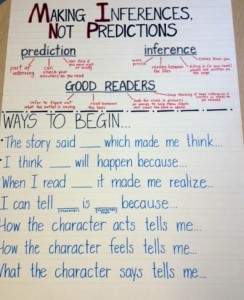The answer is simply–not simple! One of the hardest reading skills for students is inferring and it can all start with a prediction. A prediction is when a student decides what they think will happen next based upon the text, the author and their own background knowledge (schema). Students say it is a “guess” and it is but it must be based on the clues that are provided in the story or from your schema. Inferences are when a student decides what happens or why something is happening based on clues and experiences. So, you are thinking–exactly–these are the same! But, not exactly!
Predictions are actually a basic form of inferring and should begin happening in K-2 classrooms. A prediction is the perfect way to model for students how to make inferences AND to be able to show them if they were right or not. An inference is not always validated and you may not find out if you were correct but predictions are normally confirmed or refuted. In addition, our inferences (guesses using clues and knowledge) often lead to drawing conclusions which further complicates the issue.
BOTTOM LINE–
Begin teaching Predictions! Once students see how predictions work and how they use clues and their background to make a “guess” than you can move on to working on inferences which is dealing with a much more abstract concept. When students make a prediction have them explain their reasoning and really focus them back to evidence in the text or text structure. After the event, model for students how to review their predictions–Why was it right? What evidence did the author give us? What hints were given? Why was it wrong? As the teacher Model, Model and Think Aloud for the student while you review over and OVER. With repetitive practice, students begin to see how we use hints, events, text structure, character’s actions and thoughts, etc. to help us make predictions. These discussion starters a great way for students to begin showing their thinking.
Follow the Clues Lesson Plan and Graphic Organizer
I have given you this video clip before but it is great for modeling predictions The Catch. Stop at .59 to predict what the boy will do–Have students explain why they make their prediction and what evidence supports it. After the event. Review the evidence–Did we think from what the author provided? Or what we wanted to happen? Stop again at 1.09 and repeat the process.
From Predictions to Inferences
When students understand how to use the text and their schema–move on to inferences. I recommend using pictures to begin.
Use Pictures of the day from any of the following resources:
- Written Document (PDF) (HTML version)
- Photograph (PDF) (HTML version)
- Cartoon (PDF) (HTML version)
- Poster (PDF) (HTML version)
- Map (PDF) (HTML version)
- Artifact (PDF) (HTML version)
- Motion Picture (PDF) (HTML version)
- Sound Recording (PDF) (HTML version)
Please put a comment at the end of this blog post with a book, video or activity you use to teach predictions or inferences. Help a colleague by sharing your ideas!
